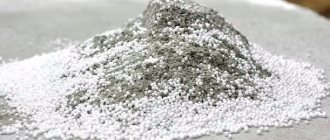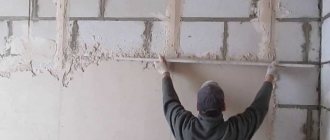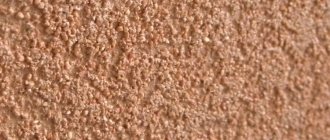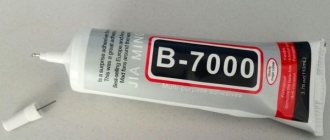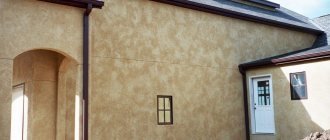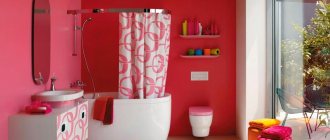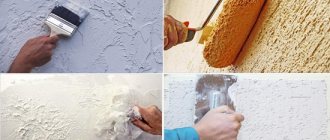Hello dear forum participants!
This is a very, very interesting discussion you are having. But it’s strange why you gradually moved from the original topic of “soundproofing plaster” to the topic of “acoustic”. These are two different things. Soundproofing plasters simply cannot exist in nature!!!!!!!!!!!!!!!!!!!!!!!!!!!!!!!!!!!!!!!!!! !!!!!!!!!!!!!!!!!!!!!!!!!!!!!!!! Sergey is absolutely right!!! He once again proved the competence of the consultants of this forum. I will answer your question. There is absolutely no point in using them! You won't notice a difference by ear from what was before. A little about the basics of sound insulation and sound absorption. Everyone knows that a half-brick partition provides 42-43 dB of airborne noise insulation, a brick partition (i.e., twice as heavy and twice as thick), what do you think??? 84-86 dB?? NO. a brick partition has an airborne noise reduction index of 48-49 dB. An increase in the mass of the structure leads to an increase in sound insulation by 6 dB. And this is in theory, but if we take into account the indirect transmission of sound... well, the question is different. Knauf tongue-and-groove slabs - gypsum, Density -1250, thickness 10, SI -39dB, according to design code 23-103-2003 there is also foam concrete Density -1000, thickness 10, SI -37dB. If we convert into kilograms, the 1st is 125 kg/m2, the 2nd is 100 kg/m2. So a difference of 25 kg per square gives only 2 dB. Your so-called “soundproofing” plaster has a surface density of 6 kg/m2 per 1 cm of thickness, i.e. in order to achieve 42-43 dB at the tongue-and-groove ridge (for a density of 1000 kg/m3), you need to plaster as much as 16 cm thick!!! I think this is a very labor-intensive process, moreover, the wall will turn out “golden”. A high airborne noise insulation index is achieved by using multilayer structures where the mass-elasticity-mass principle works. But this is a completely different story. Better assemble additional soundproofing cladding on a metal frame, with a distance from the wall (preferably 50 mm), with filling the internal space with an effective sound absorber. Naturally, there is no need to attach it to the insulated wall. The frame must be adjacent to the enclosing structures through an elastic gasket. Then the whole thing is sheathed with a layer of gypsum fiber board + gypsum board. But acoustic plasters exist in nature and are very actively used (by us, among others) because they are effective and very convenient, and to correct acoustics in rooms, acoustic sprayed coatings are used, for example, based on cellulose made in the USA. Regarding the fact that the sound becomes muffled, I agree, the soundproofing ability of the plastered surface practically does not increase, but the sound that passes into the room and is reflected from the other enclosing surfaces, when it hits the layer of acoustic plaster, is partially absorbed, and it is due to this effect that the room becomes muffled. and it seems that sound insulation has increased. Sincerely, Dmitry Denisenko sound insulation forum consultant
forum.yourdom.ru
Material characteristics
Soundproofing (acoustic, sound-absorbing) plaster is a type of finishing mixture based on mineral and polymer components, which can create a kind of barrier and protect the room from extraneous sounds. Simply put, a layer of such plaster will significantly reduce the noise level in the house.
Often, soundproofing plaster is used to cover walls and ceilings between floors. It is also used for finishing work inside houses and apartments, and public organizations. The unique properties of the material are due to its high porosity - it is thanks to this structure that it is able to capture and “dampen” some of the extraneous noise. The plaster also contains light fillers - special granules up to 5 mm in size, which have a hollow structure, lighten the weight and enhance the soundproofing function. In addition, such a building mixture will seriously improve the thermal insulation of the house, so other heat conservation work may not be required at all.
Soundproofing coating made of acoustic plaster
Acoustic panels for finishing
You can improve the sound insulation of walls and ceilings using special panels, for example SonoPlat, ZIPS-Vector Sandwich Panel, etc. This product is a thin, heavy board made of pressed wood-fiber sheet.
In the thickness of the panel there are corrugations filled with fine mineral filler.
With a thin thickness of only 12 mm, the panels have an airborne sound insulation index of 38 dB, which makes them effective in this area.
Soundproofing panels are able to absorb noise over the entire frequency range. In addition, the use of this soundproofing method eliminates so-called sound bridges. The panels reduce the transmission of vibration through the wall, which is why they effectively dampen impact noise.
The only drawback is its significant weight; the SonoPlat Standard has 16.7 kg/m².
Installation of sound-absorbing panels under plaster:
- Wet processes such as screeding and plastering must be completed before this. SonoPlat is used in both framed and frameless sound insulation systems.
- Standard panels have dimensions of 1.2 x 0.6 m and 1.2 x 0.8 m; they are easily cut with a knife, like gypsum board sheets.
- The panels are attached to the supporting structures of the house with mounting adhesive or using dowel-nails. All work must be carried out at normal air temperature and humidity.
- After installing sound insulation, decorative finishing is done. The panels are puttied, and then wallpapering, decorative plaster or painting occurs.
This video shows the process of installing panels for soundproofing an apartment:
Application of plaster
The areas of use of soundproofing plaster are varied:
- Offices. The material will create a comfortable, calm environment in the workplace and will help increase the productivity of employees.
- Libraries. Here the level of sound insulation should be the highest, so most often plaster is used in combination with other soundproofing materials. Otherwise, working with books, magazines, and printing activities will be difficult.
- Houses of culture, conference rooms, call centers, theaters. In such establishments it is always quite noisy. To reduce the level of extraneous sounds in free rooms, employee rooms, offices, utility rooms, the highest quality sound insulation is necessary.
- Cinemas. The sound absorption rate of the walls should be optimal. Otherwise, sounds from the adjacent cinema hall will greatly distract viewers while watching films.
- Government institutions. In such places, soundproofing plaster is used very often. It allows you to maintain a comfortable stay for visitors inside the organization, and also contributes to more productive work for specialists.
- Cafes, restaurants. People go to catering establishments not only to eat, but also to relax in a relaxed atmosphere. The use of soundproofing materials will protect people from extraneous sounds and have a pleasant time.
The use of soundproofing plaster when finishing an office
In addition to public organizations and institutions, soundproofing plaster is no less often used for finishing residential buildings and apartments. In typical multi-storey buildings, compliance with the standards for permissible noise levels is rarely observed; as a result, audibility in apartments is high. Residents have to think through their own soundproofing systems, and acoustic plaster will come in handy. If the material is used correctly, you will be able to relax peacefully, and noisy neighbors will not interfere with this.
Acoustic plaster is especially suitable for houses and apartments with dense walls, because the denser the base material, the better and faster sounds are distributed through it. No less in demand is plaster in housing located near busy highways, as well as where buildings are adjacent to various industrial enterprises. Since most soundproofing building mixtures have sufficient moisture resistance, they can be used even in the kitchen, bathroom, and toilet without the risk of cracking and getting wet.
Where is sound insulation used?
During the construction of some public buildings, great importance is given to noise protection. Thanks to such protection, people can rest peacefully without being distracted by extraneous sounds. Thus, in theaters, restaurants, concert halls and other entertainment premises, the walls are treated with noise-proof plaster, which does not allow street noise to pass through.
This type of insulation finish to combat loud sounds is also used in libraries, reading rooms, offices, courts and other public buildings. Considering that sound-absorbing plaster can protect even such large rooms from noise, you can be sure that it will be able to create comfort and coziness in your home.
Plastering and sound insulation do not cause any harm to the health of the inhabitants of the home. Therefore, soundproof plaster is even used on walls in children's rooms. At the same time, it is not necessary to decorate it with decorative materials. This type of plaster can be decorated by applying a simple pattern to it.
Plaster composition
Acoustic plaster is usually based on cement or gypsum, although modern silicate materials are also commercially available. The most popular fillers with a low specific gravity are vermiculite, slag, expanded clay, crushed pumice with a grain size of less than 5 mm. In order for the material to provide optimal sound insulation, the filler grains must be almost the same size, and the ratio of base and filler should be 1:4. As for the grain density, for slag it is 800 kg / cubic meter. m, and for pumice - only 400 kg / cubic meter. m, therefore, the second material will be more effective in use.
To enhance the soundproofing properties, aluminum powder is often added to the plaster, which releases gas as the mass dries, making the solution more porous. In the loose internal structure of the plaster layer, sounds are weakened or completely lost, repelled by small particles. Therefore, they practically do not reach housing.
Pumice granules to improve the soundproofing properties of plaster
General concepts
Sound refers to mechanical vibrations from 20 to 20,000 Hz. The human ear cannot hear frequencies higher or lower. An unwanted sound that interferes with concentration or relaxation is what we call noise.
Soundproofing, or otherwise acoustic plaster, refers to special types of protective finishing coatings.
The selection of its structural composition is based on the use of physical laws of propagation of wave oscillations in an inhomogeneous medium. To describe this in detail, you need to outline entire sections of acoustics.
In practice, it is usually sufficient to know that soundproofing plaster is saturated with tiny pores, and 2/3 of it itself consists of granules of substances that do not transmit mechanical vibrations well. Fiber materials are also added to some compositions to increase sound-damping properties. The result is a porous substance in which sound vibrations are intensively attenuated or reflected.
Advantages and disadvantages of the material
Soundproofing plaster has many advantages that distinguish it from other acoustic materials:
- ease of dilution, application, no need for special knowledge and skills;
- safety for the environment and human health, can be used in any premises;
- no need for thorough preparation of the base, sealing medium and small defects directly with plaster;
- reasonable price of material, availability;
- versatility, solving several problems at once - sound insulation, thermal insulation, leveling and decorative finishing (in some cases);
- high noise retention rate (35% higher than when using some sheet materials), which is largely due to the seamless coating.
There are also disadvantages to using soundproofing plaster. If you invite hired specialists to apply it, the total cost of repairs can increase significantly. When it is necessary to cover the plaster with thin wallpaper or paint, you will have to additionally apply putty, and this will also increase the cost of finishing and increase labor costs. However, if the relief surface of the plaster suits the style of the room, it can be left without additional decoration.
Textured plaster with soundproofing properties in an apartment
Myths and misconceptions
There are a lot of negative opinions about the plaster used online. According to some users, plaster is not able to provide the proper level of sound insulation, especially in comparison with modern sheet and roll materials. But craftsmen with extensive experience point out that with negative experience, there is often a violation of the application technology or incorrect finishing decoration.
In order to qualitatively finish an apartment or house with soundproofing plaster, you need to consider the following:
- Do not apply thick paints, enamels, or lime to the layer of material. They have too strong a texture and clog the pores of the plaster, thereby disrupting the sound absorption processes in the thickness of the layer. Thick wallpaper, which has to be glued with a large amount of viscous glue, can act in a similar way. For finishing, it is best to use special acoustic paint, which does not at all impair the performance properties of the solution.
- There is no need to skimp on the amount of plaster used. It must be applied along the entire perimeter of the room, and not just on the outer walls or those that border the neighbors. You should also follow the manufacturer's recommendations regarding the thickness of the plaster layer and do not reduce it. Typically, already with a thickness of 1.5 cm, the material seriously reduces the noise level in the home.
- To enhance sound insulation, you can make a special air gap between the wall and the plaster, filled with fibrous raw materials (for example, asbestos fiber). Instead of such fiber, you can lay a metal mesh with small cells (1*1 cm) so that “air pockets” are formed inside, and it is even more difficult for sounds to penetrate the house.
The purpose of partitions in a log house
Installation of interior partitions should be carried out after the shrinkage of the house is completed. The installation of partitions is done when there is a need to make changes to the layout of the building. Such partitions are not load-bearing, but at the same time they must be responsible for the heat and sound insulation of the rooms.
Partitions in a wooden house can be easily dismantled or moved to another place, without the involvement of specialists. This indicator is considered the main difference between a load-bearing wall and a partition in a log house.
Considering that the partition is located inside the structure, materials for sound insulation must be environmentally friendly. In addition to being environmentally friendly, the material must be non-flammable, since in the event of a fire, the insulation can contain the flame and prevent it from spreading to other rooms. And, perhaps, the main requirement for materials is their effectiveness in noise absorption.
Applying the material yourself
There are two ways to apply the solution - manual and machine. They usually treat small areas with their own resources, since the cost of plastering units is quite high, and it makes no sense to purchase or rent them. Large rooms can also be finished manually, although this will take more time. For high noise levels, it is better to use a combined method that includes several types of soundproofing materials.
The recommended thickness of the plaster layer is 1.5-3.5 cm, and with the combined method - from 5-10 mm. Other soundproofing materials can be used only after the plaster has completely dried. When arranging wet rooms, it is worth using cement and polymer mixtures; for dry rooms, gypsum solutions are more suitable.
Tools and consumables
For plastering work, you will need a container and a construction mixer for mixing the mass, as well as rags, water, and a stepladder for ease of applying the solution at height. To level the plaster, you need to prepare spatulas of different sizes, a trowel, a grater, and a rule.
Surface preparation
Remove old, peeling plaster from the wall, which does not hold tightly and can quickly crumble. Otherwise, during operation, large pieces will come off the wall along with the new plaster. Traces of oil, petroleum products, fuel oil and rust are wiped off with a solvent so that they do not appear on the surface, otherwise the adhesion force to the solution in such places will decrease.
Large defects, cracks, chips are covered with cement mortar. The walls are primed with 2 layers of deep penetration soil. If necessary, install the metal mesh using self-tapping screws.
Primer of the surface with concrete contact
Preparation of the solution
Pour water into a large container in the amount indicated on the plaster packaging. Gradually pour in the dry construction mixture and mix each portion thoroughly with a construction mixer. The goal is to obtain an even mass with no lumps. Typically, 30 kg of dry construction mixture requires 9-12 liters of water. After 5 minutes, mix the plaster again, after which it will be ready for use.
If necessary, prepare the plaster yourself from cement and sand (1:2 or 1:3), add a little lime to the composition to increase plasticity (no more than 10%), then add ¼ of the filler. To increase strength and density, the composition is supplemented with a hardener (up to 2%), and to optimize acoustic properties - with aluminum powder. After dilution, any cement plaster must be used within 2-4 hours, but for gypsum compositions this figure is an order of magnitude less.
Applying the solution to the surface
The composition should be worked at air temperature within +16...+25 degrees, humidity - up to 60-75%. If necessary, beacons are installed (usually they are needed if you do not have the skills to plaster surfaces and properly level walls). The first layer, the grout, is made of a small thickness (up to 1 cm), leveled according to the rule, and allowed to dry completely. A day later, another layer is applied. It is important not to overdo it with the thickness of the layer, because if you increase it beyond 2.5 cm, cracks will appear on the surface during drying.
It happens that in one pass it is not possible to cover the entire wall with mortar. In this case, a thin layer of mass is applied to the treated edge (about 1/3 of the usual thickness). When resuming work, cover the overlapping edge with new plaster, aligning it with the rest of the plane. After the solution has completely dried, the finishing is done with water-based or other loose paint, preferably also with soundproofing properties.
Ways to improve sound insulation of an apartment
The sleep of city apartment residents is often disturbed by various sounds. This could be the hum of a car engine outside the window, the clicking of heels on the sidewalk, or loud music coming from neighbors.
The correct selection and installation of soundproofing materials will help prolong the sleep of the owner of urban real estate. We will get acquainted with such products in our article.
What ways can help improve sound insulation?
Methods for dealing with extraneous sounds depend on the type of products used. To insulate an apartment from penetrating noise, you can use various rolled materials, mineral wool slabs and plasterboard sheets. Let us describe the features of each of these methods:
- Before laying plasterboard sheets on a special frame or gypsum mortar, all cracks in the base must be repaired, then a layer of plaster is applied.
- The maximum effect of sound insulation can be achieved by filling the gaps in the sheathing with mineral wool or polystyrene foam. The joints between these materials are filled with polyurethane foam.
- After installing ecowool on the surfaces of walls or ceilings in a city apartment, you can not only reduce the level of penetrating noise, but also improve the thermal insulation performance of enclosing structures.
- Decorative panels made of basalt fabric will transform the appearance of the ceiling and give it additional soundproofing qualities.
- A good effect can be achieved by installing a suspended ceiling in an apartment. This design creates an acoustic effect and protects living spaces from penetrating noise.
- Sound-absorbing materials with a film backing are mounted on a pre-leveled surface using Bustilat glue.
There is a huge selection of sound-absorbing materials on the modern construction market. Each of these products differs from others in quality and technical characteristics. The main thing is to choose an acceptable option in terms of price and quality. After installing it, you can enjoy the silence in the house.
Sound insulation for walls
Primary, insufficient sound insulation of walls can be considered a layer of plaster, putty, sealant, and damper tape. In the apartment, engineering systems are located in different places. A lot of extraneous noise is transmitted through pipes and ventilation ducts. An even greater number of extraneous sounds penetrate into living spaces through cracks, joints of various materials and sinks on the surface.
Defective areas can be repaired using sheets of mineral wool, which is additionally masked with plasterboard. The main disadvantage of this method of sound insulation is considered to be a significant reduction in usable space in the apartment.
You can reduce the influence of extraneous sounds by sticking polystyrene sheets on the base surface of the walls. This is a material close to foam plastic, but it differs from its analogue in its precise geometric dimensions and increased rigidity, and the ability to muffle loud sounds even with a small layer thickness.
Expanded polystyrene slabs can be fixed on a pre-arranged sheathing under plasterboard or on an adhesive mixture with additional fixation with plastic dowels. Such products are inexpensive; even an inexperienced builder can install them on the wall.
If you have enough financial resources, it is better to cover the walls in the apartment with polyurethane slabs. A good sound insulation effect can be achieved by using special soundproofing panels. Such products appeared on the modern construction market relatively recently; the cost per square meter of material starts from 500 rubles.
Soundproofing materials for ceilings
On the modern construction market you can find a huge amount of materials for soundproofing ceilings.
Next, let's take a look at the descriptions and characteristics of the most popular soundproofing products: Isotex panels with a thickness of 1-2.5 centimeters take up the insignificant height of residential premises.
Properly mounted products on the ceiling surface allow you to absorb sounds with a frequency of up to 23 decibels. The front surface of soundproofing panels has a protective layer of foil. The tightness of the connection of such elements is ensured by liquid nails or a tongue-and-groove system for fastening parts. Effective and high-quality sound insulation Isoplat has a thickness of 2.5 centimeters.
Such products can be used for installation on suspended, false and suspended ceilings. Izoplat slabs are made from natural raw materials of coniferous wood. This material absorbs airborne and impact noise well and is environmentally friendly for installation in an apartment. The sound absorption coefficient depends on the thickness of the panel and ranges from 23 to 26 decibels. The slabs are attached to the ceiling surface using a special adhesive mixture.
Combined method
It will not work to seriously increase the thickness of the plaster in order to protect the apartment from noise even more effectively - the mortar will simply crack and fall off. The ideal option would be to use a combined sound insulation system, which includes so-called “layered” sound-absorbing coatings. Most often, a layer of mineral wool, basalt sheet material or foam is laid under acoustic plaster. Corrugated cardboard boards with filler are also suitable for this purpose.
After the glue on which the sheet materials were attached in a layer of at least 2 cm has dried, the surfaces are plastered. As a result, when passing through materials with different densities, sounds are absorbed even more strongly. At the same time, heat saving in the room is effectively increased. The disadvantage of the combined sound insulation method is only a reduction in the free space of the home, because the coating will have an impressive thickness.
Popular plaster manufacturers
High-quality plaster is durable, reliable, and environmentally friendly. Such materials are produced both foreign and domestic
This company produces good building mixtures under the Paladium brand, and they are not inferior in properties to imported compounds. The sound and heat insulating solutions of this company contain foam glass as a filler, so they additionally have fire-fighting properties. Plasters are used for external and internal work, serve for decades, are durable and do not shrink. The material is resistant to the development of mold and mildew, and is not afraid of moisture and temperature changes.
Soundproofing mixture PalaplasteR-207
Ivsil
The company produces plasters using the most modern technologies, and the cost of the finished product is quite affordable.
Soundproofing plasters of this brand are widely used in residential and industrial construction. They are based on cement, polymers, and special fillers (the exact composition is considered unique and is not publicized). Ivsil plaster is characterized by the following properties:
- excellent sound and heat insulation;
- fire safety, absence of flammable components;
- layer thickness - 10-50 mm;
- low risk of cracking and shrinkage;
- light weight.
"Favorite"
The company is a Russian manufacturer of dry and ready-made finishing materials. Soundproofing plasters are produced under the De Luxe brand. They are used in interior and exterior work and are characterized by moisture resistance, frost resistance (–50…+50 degrees), economical consumption and low price. The mixtures are made on the basis of cement, sand, cellular glass and polymer additives. The coating can be applied in a layer thickness of 5-40 mm.
Cement-based heat- and sound-insulating mixture de Luxe
Knauf
The Knauf company can rightfully be called a world leader in the production of construction and finishing materials that are of the highest quality. Among the wide range of dry mixes there is Knauf AkustikPutz plaster, which has noise-proof properties. It contains gypsum, mineral additives and special fillers with a fraction of 3-5 mm. After application in a layer of 5-15 mm, a high-strength coating is created that is resistant to the influence of temperature changes and mechanical factors.
Plaster mixture Knauf Akustik puts
The use of soundproofing plaster will allow you to get rid of extraneous noise at no extra cost and make your stay in a house or apartment comfortable. This is a simple and reliable way to get rid of unpleasant phenomena in offices and public buildings, so it’s worth taking it into service.
